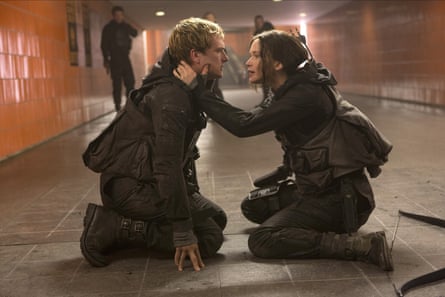The second Bourne film, the fourth Hunger Games movie, an indie flick about a teen assassin and one of the highest-grossing instalments in the Marvel cinematic universe. If that were the IMDb page of an actor, you would think they were on their way to the big time. But the CV in question belongs not to a person, but a tunnel in Berlin.
Since doubling as the exterior of a Moscow airport in 2004’s The Bourne Supremacy, the distinctive orange-tiled walls and pillars of the Messedamm underpass have been seen in Joe Wright’s Hanna in 2011, 2015’s The Hunger Games: Mockingjay – Part 2, last year’s Captain America: Civil War and Charlize Theron spy thriller Atomic Blonde, released earlier this month.
These are no fleeting cameos, either. The underpass is the scene of the lengthy fight between Eric Bana’s Erik Heller and four CIA agents in Hanna, while it bookends Katniss and her fellow rebels’ sewer escape from Panem in Mockingjay – Part 2. Black Panther’s breathless chase of Bucky, Falcon and Captain America takes place in the tunnel (although this time it was doubling for Budapest, Hungary), culminating in their arrest on the exact same spot, in the tunnel’s open-air section, where Charlize Theron’s Lorraine is also dragged from the wreckage of a crashed car in Atomic Blonde.
Markus Bensch is the location manager for Berlin-based Studio Babelsberg. If the Messedamm underpass appears in a film, it is because he suggested it.

“I always warn directors that it has been in these films, but they like the location and they are not dissuaded,” he says. “It makes it look as if we only have two locations here in Berlin; the underpass and Tempelhof airport.”
Often, he says, when he shows a location such as the underpass to a director, the script is rewritten to accommodate it. The fight scene in Hanna, for example, was adjusted to use the underpass, while the film’s showdown ending was altered so it could be shot in the creepy abandoned amusement park Bensch found.
Messedamm underpass may well be the most-widely used non-landmark location in film, run close only by Berlin’s Kraftwerk Mitte, a former power station-turned-nightclub also used in The Hunger Games – it is the scene of Katniss’s archery training.
But filming locations have a shelf life. Things already seem as if they are slowing down, although only last month the second series of Berlin Station, a US series starring Richard Armitage, shot there, suggesting we haven’t seen the last of those orange walls just yet.
“Locations such as these have a busy spell and then no one will film there for four or five years,” says Bensch. “It’s the same with cities as a whole. Some places are just in fashion and then they are left alone until the industry decides to go there all over again.”
Anyone planning to use the tunnel, however, will have to seek permission from its current occupiers. The underpass sits beneath the Internationales Congress Centrum, an aluminium-skinned former conference centre, home to 600 refugees since December 2015.
The spot of Captain America’s arrest and Atomic Blonde’s car crash? That is now used by the refugees as a basketball court.
- This article was amended to correct the location of Budapest

Comments (…)
Sign in or create your Guardian account to join the discussion